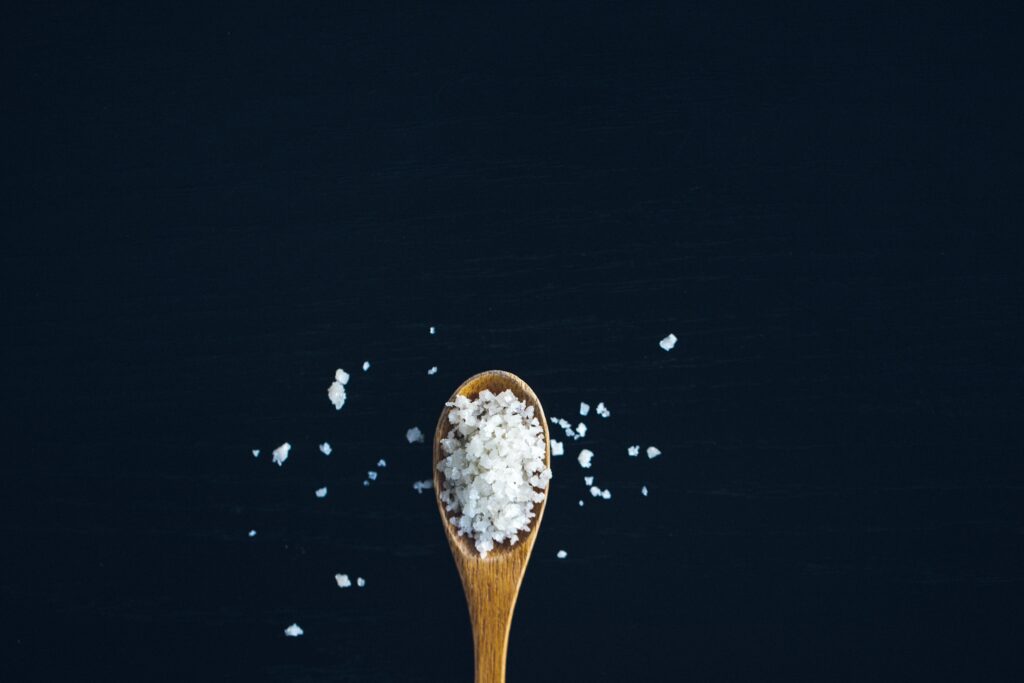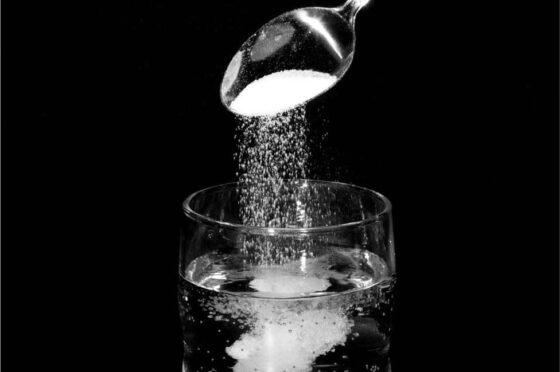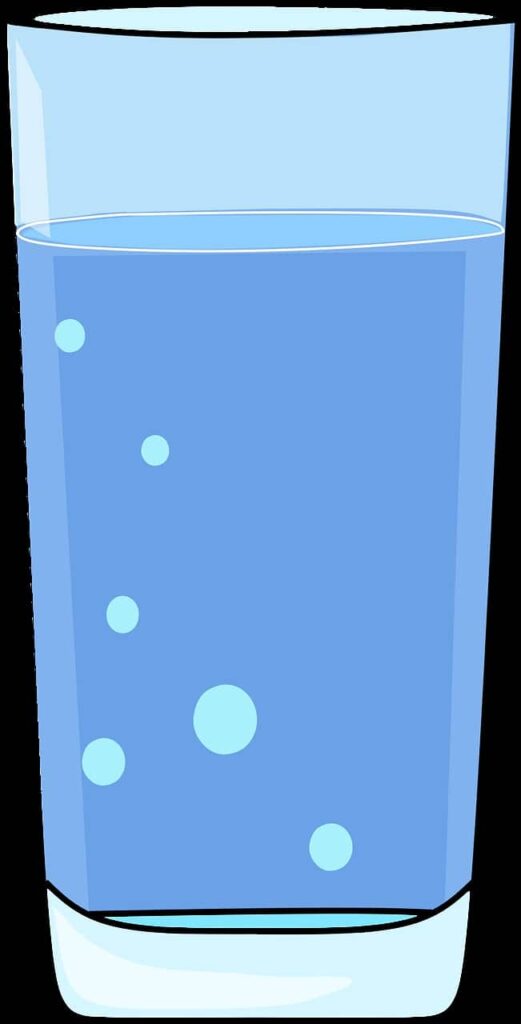We have all grown up to the sight of salt dissolving in water. And if you have been keen, you may have noticed that the more salt is added to water, the longer it takes to disappear — sometimes, that may require some stirring or shaking. But why does salt dissolve in water?
The basics: water and salt

Water
Water (H2O) is composed of two elements: hydrogen (H) and oxygen (O), or more precisely, two hydrogen atoms (H2) and one oxygen atom (O). This means there are two H atoms for every O atom in water.

Because oxygen is about 16 times more massive than a hydrogen atom, the water molecule is nearly nine-tenths oxygen by mass. As a result, both oxygen and hydrogen are gases at room temperature.
Water is a solid at temperatures below 0 °C, a liquid between 0 °C and 100 °C, and gas when temperature surpasses 100 °C. It is polar — meaning it has positive and negative charges on the opposite side of its molecules.
While water has no net charge, its polarity creates a somewhat positive charge on hydrogen and a somewhat negative charge on oxygen, contributing to water’s properties of attraction.
Salt
Sodium chloride (NaCl), commonly known as table salt, is an ionic compound, meaning that the bond it forms results from the transfer of an electron from one atom (in this case, Na) to another (Cl).
This bond is highly electronegative, so when NaCl is dissolved in water, the results are almost seen immediately. When salt is mixed with water, the salt dissolves because the covalent bonds of water are stronger than the salt molecules’ ionic bonds.
Why is water referred to as the “universal solvent”?
Water can dissolve a wide range of various substances, which makes it an excellent solvent. As a result, water is also known as the “universal solvent” since it dissolves more compounds than any other liquid.
This is critical for all living things on the planet. It means that wherever water flows, whether through the ground or our bodies, it carries valuable molecules, minerals, and nutrients.
Water’s chemical makeup and physical properties make it a good solvent. The oxygen and hydrogen atoms in water molecules are arranged polarly, with one side (hydrogen) having a positive electrical charge and the other (oxygen) having a negative charge.
This allows the water molecule to be attracted to many other molecules. Water can become so strongly attracted to another molecule, such as salt (NaCl), that it can disrupt the attraction forces that hold the sodium and chloride in the salt molecule together, causing it to dissolve.
A solvent is a material capable of dissolving other molecules and compounds known as solutes. A solution is a homogenous mixture of solvent and solute, and much of life’s chemistry occurs in aqueous solutions, or solutions containing water as the solvent.
Everything is not dissolved by water.
Despite its moniker as the “universal solvent,” water does not dissolve or dissolve poorly with numerous substances. The solubility will be low if the attraction between opposingly charged ions in a chemical is strong.
Most hydroxides, for example, have a low solubility in water. Furthermore, many organic substances, such as fats and waxes, do not dissolve efficiently in water because they are nonpolar molecules.
What liquids are incapable of dissolving in water?
Because many compounds are non-polar and do not interact well with water molecules, they do not dissolve in water. Oil and water are two common examples. Oil comprises non-polar molecules, which do not dissolve in water.
Salt dissolved in water: Molecular interactions.

Salt dissolves in water at the molecular level due to electrical charges and the fact that both water and salt molecules are polar, having positive and negative charges on opposite sides of the molecule.
Ionic bonds exist in salt compounds because they have an electrical charge—the chloride ion is negatively charged, and the sodium ion is positively charged.
Similarly, a water molecule is ionic, but the link is covalent because two hydrogen atoms with positive charges are positioned on one side of an oxygen atom with a negative charge. When salt is mixed with water, it dissolves because water’s covalent bonds are stronger than the ionic bonds in salt molecules.
The positively-charged side of water molecules is attracted to negatively-charged chloride ions, while the negatively-charged side is attracted to positively-charged sodium ions.
A tug-of-war ensues, with the water molecules emerging victorious. Water molecules pull the sodium and chloride ions away, breaking the ionic link that holds them together.
After the salt compounds are separated, the sodium and chloride atoms are surrounded by water molecules. The salt is dissolved. As a result, resulting in a homogenous solution.
The elements
When NaCl is mixed with water, the somewhat electropositive sodium portion is attracted to the somewhat electronegative oxygen portion of water molecules. Simultaneously, NaCl’s somewhat electronegative chlorine portion is attracted to water’s somewhat electronegative oxygen portion.
In both cases, no bond is formed; rather, the covalent bonds of H2O and the ionic bonds of NaCl are strained. Thus the “tug-of-war.” Eventually, the stronger covalent bonds of water (which are held together by hydrogen bonds between water win out), pulling NaCl apart. As a result, table salt is dissolved — it dissociates into its respective cations and anions, Na+ and Cl-.
Does temperature affect how quickly salt dissolves in water?
Yes, it does. Salt dissolves quicker at room temperature than in cold water. Likewise, salt and other ionic compounds like it will dissolve quicker the hotter the water it is dissolved in. That is because hot temperatures make atoms move quicker, and the quicker they move, the easier they come apart.
Takeaway
- The polarity of water molecules allows water to dissolve many ionically bonded substances.
- The amount of a substance that can dissolve in a liquid (at a specific temperature) is called the substance’s solubility.
- Water dissolves salt because the positive part of water molecules attracts the negative chloride ions, and the negative part attracts the positive sodium ions.
- Salt (sodium chloride) is made from positive sodium ions bonded to negative chloride ions.
- The dissolved substance is called the solute, and the dissolving substance is called the solvent.

Jay
Jay is a health and wellness enthusiast with expertise in water quality and nutrition. As a knowledgeable advocate for holistic well-being, Jay successfully manages Type 2 Diabetes through informed lifestyle choices. Committed to sharing reliable and authoritative insights, Jay combines firsthand experience with a passion for enhancing health."
